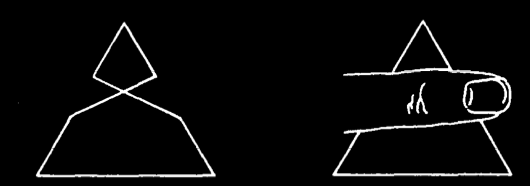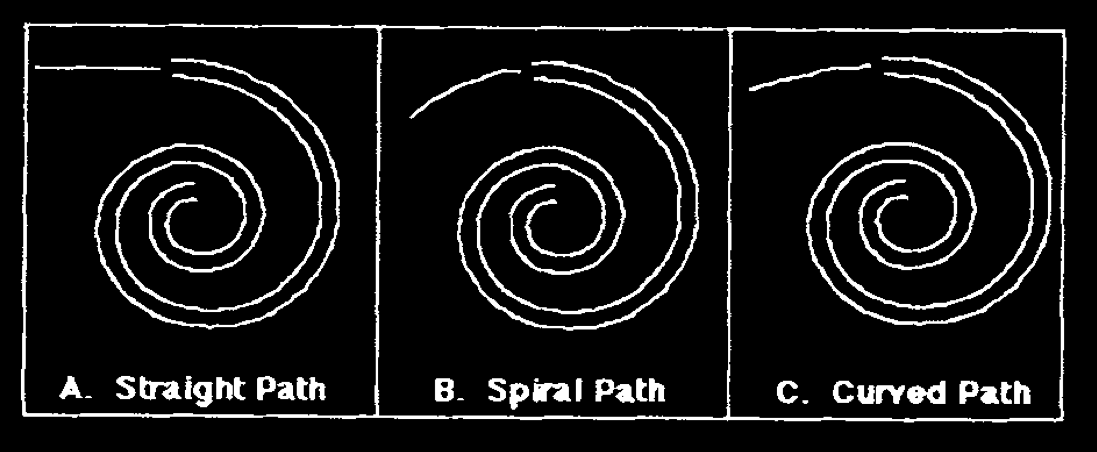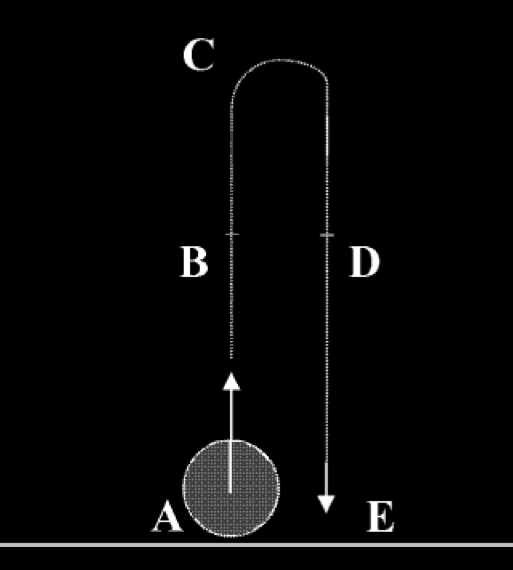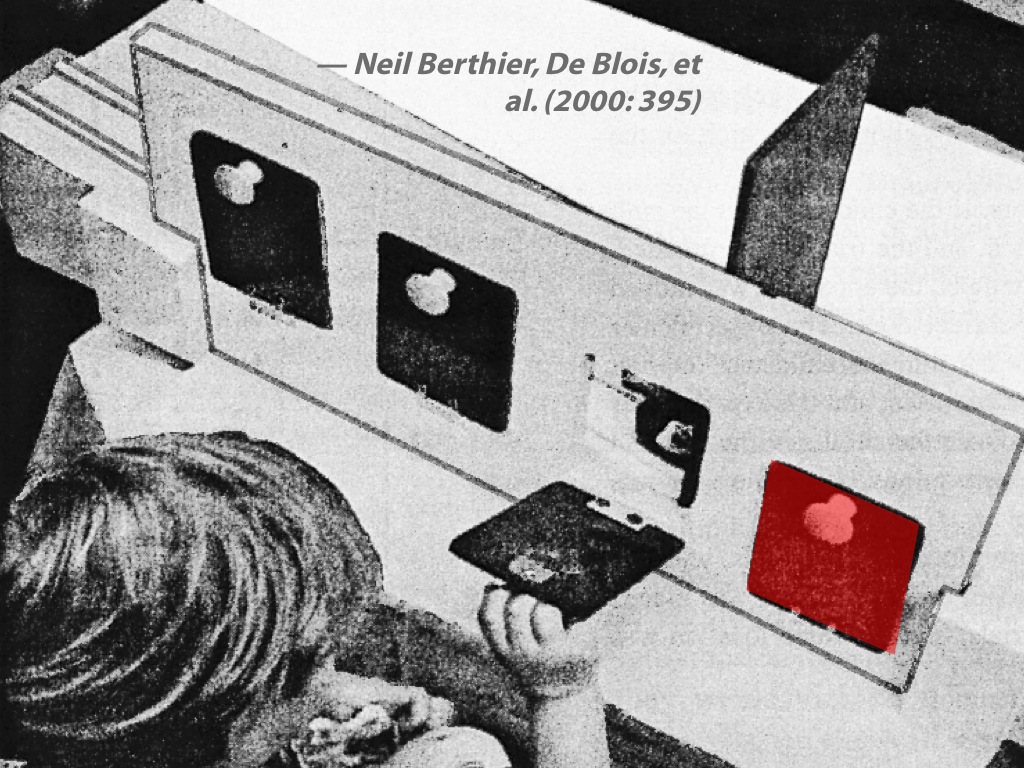Press the right key for the next slide (or swipe left)
also ...
Press the left key to go backwards (or swipe right)
Press n to toggle whether notes are shown (no equivalent if you don't have a keyboard)
Press m or double tap to see a menu of slides
Perceptual Expectations
Recall that the Principles of Object Perception generate expectations in infants.
For example, we saw (in the previous lecture) that infants expect objects to be in certain
locations, or to appear at
certain points in space.
What is the status of these expectations?
Our recent identification of the Principles of Object Perception with the operation of object
indexes suggests that the expectations are in some sense perceptual.
But what are perceptual expectations?
And do adults also have perceptual expectations?
Infants have expectations, but what about adults?

\emph{source}: Michotte et al (1964) via Kellman and Spelke (1983, figure 2)
Michotte et al (1964) via Kellman and Spelke (1983, figure 2)
There are perceptual expectations.
Suppose you saw this image.
The triangle behind the thumb is in some sense perceptually present, even though you can't see it.
But now the thumb comes away and what you see is not the triangle you were expecting.
Could these perceptual expectations be just a matter of knowledge?
No, because perceptual expectations are judgement-independent.
As \citep{kellman:1983_perception} report, Michotte, Thines and Crabbe found that subjects report seeing a single large triangle behind the thumb even when they know that there isn't one there.
You can cover and reveal the triangles repeatedly, but the expectation will hold firm.
The experience you have when the thumb is removed is like that of infants' in violation-of-expectation tasks.
This is what it is like to be an infant.
representational momentum
You see an object move on a screen in some way.
The screen goes blank and you are asked to say where the object was last.
Subjects typically locate the object just a bit further on, as if it had continued moving after the screen went blank.
This is called representational momentum as a sort of joke; the idea is that the representation keeps moving if the object stop abruptly enough.
It's not interesting in itself, but it's useful for us.
Why is it useful? Because it can tell us about the paths that the perceptual system expects objects to travel on.
\citep{freyd:1994_representational} ('The results are also consistent with a claim of relative cognitive impenetrability (Finke & Freyd, 1989; Kelly & Freyd, 1987) in that subjects showed a memory shift for a path that the majority of subjects did not consciously consider correct.' \citep[p.\ 975]{freyd:1994_representational})
'In Freyd and Jones’ study [(1994)], greater RM was observed for the impetus (spiral) than for the Newtonian (straight) path.'* (p. 449)

Freyd and Jones 1994, figure 1
The effect of mass on the rate of ascending motion: impetus and Newtonian theories come apart.
Important because it shows limits (people know better than their perceptual systems)
--- \citep{kozhevnikov:2001_impetus} on representational momentum

Kozhevnikov and Hegarty 2001, figure (from appendix)
adults, including trained physicists who make correct verbal predictions about the effects of mass on motion, show representational momentum (a perceptual effect) consistent with impetus and inconsistent with Newtonian mechanics. So again we have (i) judgement-independence and (ii) adults. ('both physics experts and novices possess the same set of implicit beliefs about motion.' \citep[p.\ 451]{kozhevnikov:2001_impetus})
--- limits of infants' systems found in adults shows that we can identify the system as persisting
--- note that other studies also show judgement-independence, but in the other way (implicit knowledge of physical interactions more accurate than judgement: 'a number of previous studies suggesting a dissociation between explicit and implicit knowledge of the principles of physics. For instance, Hubbard suggests that implicit knowledge reflects internalization of invariant physical principles, whereas explicit knowledge about motion may be less accurate. Similarly, Krist et al. (1993) suggested that perceptually based knowledge is more accurate than verbal concepts of motion.' \citep[p.\ 450]{kozhevnikov:2001_impetus}
--- What questions does this bear on? (1) perceptual & modular nature of infants' understanding of objects and their interactions; (2) relation between infant competence and adults' (do the thing about system being transformed or discarded versus two systems persisting through development : this is different from issues about innateness, which looks from infants' competence backwards --- here we go in the other direction, looking forwards); and (3) trade-offs between flexibility and efficiency (see below; worth talking about this in some detail here)
--- on cognitive efficiency: 'To extrapolate objects’ motion on the basis of physical principles, one should have assessed and evaluated the presence and magnitude of such imperceptible forces as friction and air resistance operating in the real world. This would require a time-consuming analysis that is not always possible. In order to have a survival advantage, the process of extrapolation should be fast and effortless, without much conscious deliberation. Impetus theory allows us to extrapolate objects’ motion quickly and without large demands on attentional resources.' \citep[p.\ 450]{kozhevnikov:2001_impetus}
**caution (basically fine, but need to be careful): 'The extent to which displacement reflects physical principles per se has been widely debated in the literature; theories of displacement suggest a variety of potential effects of physical principles ranging from an incorporation of the principle of momentum into mental representation (e.g., Finke et al., 1986) to a rejection of any internalization of physical principles (e.g., Kerzel, 2000, 2003a). The empirical evidence is clear that (1) displacement does not always correspond to predictions based on physical principles and (2) variables unrelated to physical principles (e.g., the presence of landmarks, target identity, or expectations regarding a change in target direction) can influence displacement. ... information based on a naive understanding of physical principles or on subjective consequences of physical principles appears to be just one of many types of information that could potentially contribute to the displacement of any given target' \citep[p.\ 842]{hubbard:2005_representational}
signature limits
Why is it significant that representational momenutum in adults is consistent with
objects obeying impetus mechanics rather than Newtonian mechanics?
There are two reasons.
First, the signature limits provide us with a means to identify infant with adult cognition.
If both infants and adults are subjects to the same signature limits, namely those associated
with impetus mechanics, then we can infer that the representations of physical objects in
adult 's perceptual processes originate from the same source as infants' representations of
physical objects.
Second, it shows that the perceptual expectations involved in the representational momentum
are distinct from judgements. You would not expect representational momentum to guide
purposive actions that are separated in time from the perceptual experiences.

Recall that in infants we found discrepancies between some looking and some action-based
measures of abilities to track causal interactions.
While I don't think we are yet in a position to explain these discrepancies, we can identify
them with discrepancies that are also found in adults.
I suggest that
the discrepancies bewteen perceptual expectations and verbal judgements in adults have the same
source
as the discrepancies bewteen some looking and action-based measures in infants.
Their explanation lies in the nature of perceptual expectations.
If this is right, one consequence is that infants competences do not grow into more
sophisticated adult competencies: Rather they remain constant throught development, and
are supplemented by quite separate abilities.
This, anyway, is the view I shall adopt from here on in.
infant
adult
social interaction
language
time --->